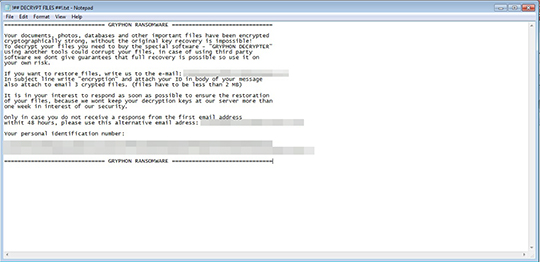RANSOM_BTCWARE.AP
Trojan.Ransom.Gryphon (ALYac); Ransom:Win32/Betisrypt!rfn (Microsoft); Win32.Trojan-Ransom.BTCWare.J (GData)
Windows


Threat Type: Ransomware
Destructiveness: No
Encrypted: No
In the wild: Yes
OVERVIEW
Dropped by other malware, Downloaded from the Internet
This Ransomware arrives on a system as a file dropped by other malware or as a file downloaded unknowingly by users when visiting malicious sites.
It is capable of encrypting files in the affected system.
It encrypts files found in specific folders. It drops files as ransom note.
TECHNICAL DETAILS
99,840 bytes
EXE
No
28 Nov 2017
Displays message/message boxes, Encrypts files
Arrival Details
This Ransomware arrives on a system as a file dropped by other malware or as a file downloaded unknowingly by users when visiting malicious sites.
Installation
This Ransomware adds the following mutexes to ensure that only one of its copies runs at any one time:
- GIVEMEBTC
Other System Modifications
This Ransomware adds the following registry entries:
HKCU\Software\Microsoft\
Windows\CurrentVersion\Run
DECRYPTINFO = "%Application Data%\HELP.txt"
Other Details
This Ransomware is capable of encrypting files in the affected system.
Ransomware Routine
This Ransomware encrypts files found in the following folders:
- %Program Files%
(Note: %Program Files% is the Program Files folder, where it usually is C:\Program Files on all Windows operating system versions; C:\Program Files (x86) for 32-bit applications running on Windows 64-bit operating systems.)
It avoids encrypting files found in the following folders:
- $recycle.bin
- msocache
- programdata
- windows
- nvidia
- intel
- appdata
- inetpub
- temp
It appends the following extension to the file name of the encrypted files:
- {Filename}.{extension}.[barbarossol051223@{BLOCKED}ta.com].gyrphon
It drops the following file(s) as ransom note:
- %Application Data%\HELP.TXT
- {encrypted folder}\!##DECRYPT FILES ##!.txt
(Note: %Application Data% is the Application Data folder, where it usually is C:\Documents and Settings\{user name}\Application Data on Windows 2000, Windows Server 2003, and Windows XP (32- and 64-bit); C:\Users\{user name}\AppData\Roaming on Windows Vista (32- and 64-bit), Windows 7 (32- and 64-bit), Windows 8 (32- and 64-bit), Windows 8.1 (32- and 64-bit), Windows Server 2008, and Windows Server 2012.)
It leaves text files that serve as ransom notes containing the following text:
SOLUTION
9.850
13.812.08
29 Nov 2017
13.813.00
30 Nov 2017
Step 1
Before doing any scans, Windows XP, Windows Vista, and Windows 7 users must disable System Restore to allow full scanning of their computers.
Step 2
Note that not all files, folders, and registry keys and entries are installed on your computer during this malware's/spyware's/grayware's execution. This may be due to incomplete installation or other operating system conditions. If you do not find the same files/folders/registry information, please proceed to the next step.
Step 3
Delete this registry value
Important: Editing the Windows Registry incorrectly can lead to irreversible system malfunction. Please do this step only if you know how or you can ask assistance from your system administrator. Else, check this Microsoft article first before modifying your computer's registry.
- In HKEY_CURRENT_USER\Software\Microsoft\Windows\CurrentVersion\Run
- DECRYPTINFO = "%Application Data%\HELP.txt"
- DECRYPTINFO = "%Application Data%\HELP.txt"
Step 4
Search and delete these files
Step 5
Restore encrypted files from backup.
Step 6
Scan your computer with your Trend Micro product to delete files detected as RANSOM_BTCWARE.AP. If the detected files have already been cleaned, deleted, or quarantined by your Trend Micro product, no further step is required. You may opt to simply delete the quarantined files. Please check the following Trend Micro Support pages for more information:
Did this description help? Tell us how we did.


